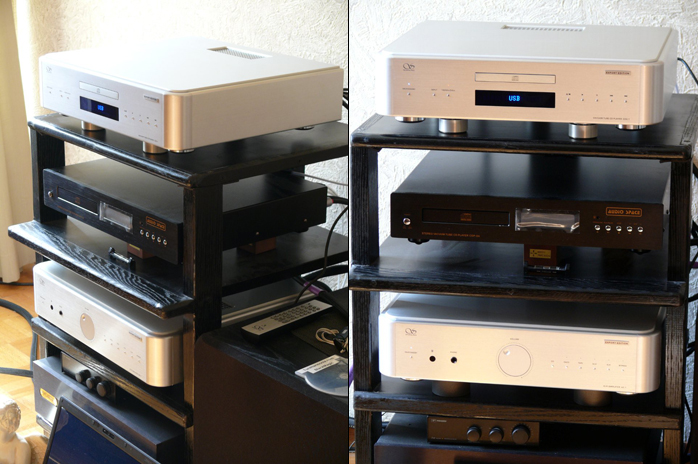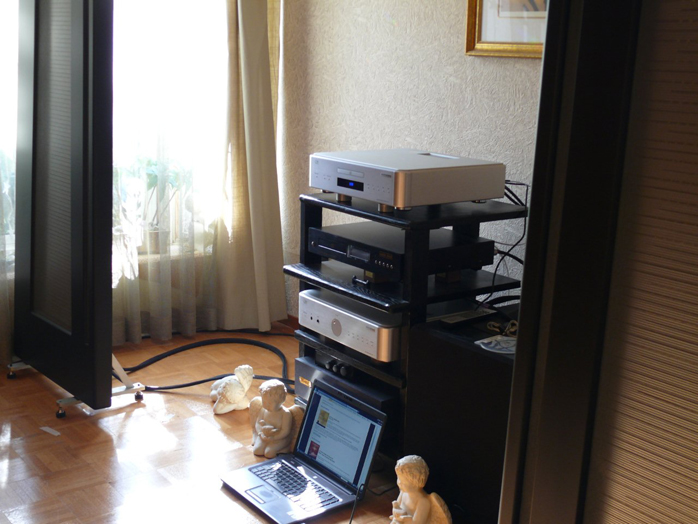This review page is supported in part by the sponsors whose ad banners are displayed below |
 |
 |
Soundstage information had good lateral precision, hall/depth cues were well resolved but highlighted the 2.1’s predisposition to transparency. Solidity became a matter of front-end choice. The AudioSpace CD 8A achieved best results followed by the Shanling’s tube outputs. The balanced Shanling output was best at revealing high levels of information but both tube stages better interpreted that information as physical objects in a real venue. The headphone stage proved no mere afterthought. The character very much mirrored the main outputs, being light on its feet with noteworthy dynamic agility of wide voltage swings. Detail was high enough and the hallmark transparency found on the main outputs maintained. Higher resolution sources were presented with detail and precision. Shanling has obviously paid attention. The capabilities should rival some dedicated headphone amplifiers.
|
 |
The listening sessions with the AudioSpace AS-3/5A speakers revealed a combination that very much favored transparency. The sound had a mid-to-upper-midrange emphasis, creating heightened detail and a see-through character punctuated by rapid dynamic response. The differences between the balanced transistor and single-ended tube outputs on the 2.1 CD player were not dramatic. The tubes carved out a little extra solidity and dimensionality and a bit of additional sweetness on top. Where the transistor path offered a slightly flatter response with better definition in the extremes, the tube stage countered with a bit of extra dynamic exuberance with additional kick and power in the lower regions. The differences were subtle and ultimately both outputs were optimized for transparency. In contrast, switching to the Audiospace CDP8A and its the tube outputs showed more traditional tube virtues, a more palpable image and a tonal balance centered on the midrange with a little more weight in the upper and mid bass area. The two sources embodied different design priorities - transparency vs. solidity.
|
 |
Initially the Shanling/AS-3/5A combination produced a reasonably refined sound but did not display the type of micro and macro dynamic prowess that had distinguished the Densen pairing. The situation improved with changes in both speaker cable and interconnects. CD player and integrated displayed an affinity for cables that matched their own temperament of extension, transparency and dynamics. Anything else compromised inherent strengths by accomplishing not a change but mismatch. That required care with the AS-3/5A because there was strong potential to compromise the speaker’s rich midrange. Adding the subwoofer proved an initial challenge too. The inability to use Paradigm‘s high-pass filter made cabling critical. Any additional emphasis in upper and midbass performance resulted in blending problems. Cool and transparent were the requirements. Once addressed the combination performed to a high standard with good dynamics, articulation and extension but a somewhat leaner midrange balance.
|
|
|
Based on those results and the published performance specifications into four ohms, I anticipated that the amplifier might have issues driving the Apogees full range. Real life listening results were totally unexpected. When the system settled in, the Shanlings played their transparency card to devastating effect. The Apogees became a more than reasonable facsimile of the Quad ESL 57s. The midrange through upper midrange blossomed with information. The lower midrange and upper bass were mildly lean but quick and uncluttered. The overall effect brought back memories of the ESL57/303 pairing. Then the Apogee/Shanling combination managed two tricks that the Quad could not - enhanced dynamics and an extreme bottom end that hit with depth, weight and precision. This was a level of performance previously reserved for amps like the H2O and Bel Canto.
|
 |
No, the Shanling 2.1 integrated did not magically become a muscle amp. It could not match the sheer unreserved horsepower of the H2O S250. Yet as long as it was driven from reasonable to somewhat impolite levels, it could constantly shock on music with short instantaneous bursts, apparently drawing on generous short-term reserves. This imbued the presentation with a liveliness that came close to the Densen B130+ in articulation and equalled if not slightly bettered its ability to achieve lifelike larger-scale swings. Of course there were absolute limits. At louder levels the material lost its composure, giving up detail and precision and becoming confused and dynamically compressed. Higher frequencies lost their effortless extension and turned coarser. These were simple realities of driving the 2.1 beyond its comfort zone. A slight downward turn of the volume restored the amplifier’s game and fearless exuberance.
|
 |
Convenience is often overlooked as a secondary accommodation. The sheer convenience of having a DAC switcher in the player was a major strength however. It opened up a world of new sources via Internet steaming and hi-rez files. The DAC may fall short of powerhouses like the Acoustic Buoy 2488 DAC which can summon up additional layers of gusto and finesse but it performed disproportionately well given its modest price. Considering how we are looking at a fully accessible DAC inside a dedicated CD player rather than dedicated high-end DAC, the unit becomes embarrassingly attractive. Shanling has managed to make the progression to the new digital frontier painless with little sonic compromise.
|
|
|
The Shanling 2.1 Export Edition CD player and integrated amplifier certainly are lookers. Form and feel embody elegance and refinement. Luckily for the audiophile crowd, their gleaming beauty runs more than skin deep. The ergonomics of both pieces achieve ease of use that's rare. Mass consumer products have long assumed the requirement of being user friendly but the High End often demands that the end user compromise convenience for sonics. Shanling bridges the gap. These products with midfi price tags play at honest High End levels. Looks, performance and convenience? That’s a lot of bang for your hard-earned buck.
|
 |
If dynamics and transparency are priorities, both pieces will satisfy. Remember that the overall flavor is decidedly solid-state, even the player’s tube outputs. Euphony is not an option. This is modern tube design. Strengths? The amplifier emphasizes cleanliness and transparency with a bottom end that's decidedly resolute and dynamic to do surprisingly well on challenging pieces. The CD player not only offers decent performance in its own right but manages to bring home the next generation of digital with a highly competitive DAC. Do these machines perform at cost-no-object levels? No. Additional money buys more refinement. Yet where Shanling is strong, it pushes close to those boundaries. If the signature sound here appeals to you, these two can be easily recommended. They are an attractive pair that won’t embarrass when they sing.
|
|
Quality of packing: Double box double thickness cardboard containers. Industrial quality open frame polystyrene caps.
Reusability of packing: Yes.
Condition of components received: Perfect.
Delivery: Hand delivered by Canadian distributor Charisma Audio.
Website comments: Extensive product information and photo galleries.
Human interactions: Professional and informative.
Warranty: 1 year parts and labor.
Final comments & suggestions: Fun, transparent and lively. The looks of upscale pieces with sufficient sonic prowess to appeal to the ear and pocketbook.
|
 |
 |
|
 |